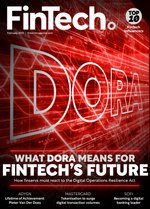Tokenisation Propels Surge in Digital Transaction Volumes

Digital commerce infrastructure faces fundamental change as financial institutions move to replace traditional security architecture with tokenisation technology, driven by escalating online fraud and the need to secure cross-border transactions.
The integration of tokenisation across sectors marks a shift from conventional data protection methods to a more dynamic approach for securing digital interactions.
Here, FinTech Magazine takes a look at the latest signals report from Mastercard, The Invisible Handshake, as we track how far tokenisation has evolved and what it means for various industries now and in the future.
Technical foundations and implementation
Tokenisation differs fundamentally from encryption in its approach to data security. While encryption disguises data by converting it into an unreadable format requiring a key for access, tokenisation replaces sensitive data with tokens that hold no intrinsic value.
The original data remains with the sending organisation rather than being transmitted in encrypted form.
The process involves converting sensitive information into randomised character strings stored in secure token vaults.
These vaults maintain isolation between original data and operational systems. During transactions, a tokenisation system receives sensitive information, such as credit card primary account numbers, and converts them into random character strings.
To enhance security, this information undergoes encryption before the payment token represents the account number throughout the transaction process.
Smart contracts enable programmable payments that respond dynamically to events or changes in the environment. This programmability extends beyond routine bank transactions to more sophisticated operations.
Tokens contain built-in instructions that activate under specific conditions, offering control and transparency while reducing risk. Applications include automated escrow accounts, fund earmarking and loan disbursement.
Payment network operator Mastercard processes more than one billion tokenised transactions weekly.
Pablo Fourez, Chief Digital Officer at Mastercard, says: “Today, more than 30% of Mastercard transactions worldwide are tokenised and we intend to continue scaling this rapidly.
“By 2030, we're aiming to eliminate the need for manual card entry and one-time or static passwords, by ensuring that every online transaction across our network can be tokenised and authenticated.”
Cross-border innovation and payment systems
Cross-border payment values are projected to increase from US$190tn in 2023 to US$290tn by 2030. Current fees average 1.5% for corporate transfers and reach 8.4% for individual remittances, representing costs up to 10 times higher than domestic payments.
Three primary vehicles drive tokenised cross-border payments, each with distinct advantages and limitations. Stablecoins, cryptocurrencies tied to stable assets like fiat currencies or government bonds, offer reduced fees and conversion costs with near real-time settlement.
However, challenges in maintaining full backing can lead to instability, as demonstrated by recent high-profile stablecoin failures.
Central bank digital currencies (CBDCs) provide enhanced transparency and streamlined transactions but remain experimental. These digital versions of fiat currencies raise potential privacy concerns and could unbalance the financial system.
Tokenised deposits, representing digital tokens of large-volume bank deposit balances, facilitate rapid cross-border transfers within private or permissioned public blockchains established by approved bank consortiums.
The cross-border token transfer process follows a precise sequence. A party initiates a fund transfer by substituting monetary value with a unique token.
This token transmits across a secure network to the receiving party, who redeems it for equivalent value in local currency. Critical transaction data, including KYC/AML compliance details, remain securely logged on the network, available to authorised parties.
This streamlined approach operates continuously, unaffected by traditional banking hours and time zone differences.
Major banks have developed proprietary platforms implementing these systems. Citigroup's treasury services division launched Citi Token Services for continuous cross-border payments using blockchain technology and smart contracts.
JPMorgan's Kinexys platform utilises the Ethereum blockchain for peer-to-peer information sharing and continuous settlement.
Digital identity and healthcare management
Online fraud cost US consumers and businesses US$12.5bn in 2023, with digital fraud rates increasing 80% above pre-pandemic levels. Identity theft affects 73% of surveyed consumers, driving demand for secure verification methods.
Generative AI and deepfakes compound these challenges by making synthetic identities more sophisticated and difficult to detect.
Tokenised credentials create portable digital IDs, securing birth certificate information, passport details, and biometrics in digital wallets. Users authenticate identities through tap-and-go interactions, selecting specific details for different situations.
Corporate applications expedite client onboarding by securing organisational information required for know-your-customer and anti-money laundering compliance.
In e-commerce, tokenised biometrics hold potential for reducing return rates. With 25% of online apparel purchases returned, tokenising personal measurements could improve size-matching accuracy. The technology extends to gaming and regulated goods industries through secure age verification processes.
Healthcare faces unique challenges with fragmented data infrastructure leading to operational costs and potential compromises in patient care.
LexisNexis Risk Solutions' Gravitas Token solution demonstrates tokenisation application in healthcare, using algorithms to de-identify and link patient data for clinical research without compromising privacy.
Protected health information tokenisation enables patients to control medical data access through programmable tokens configured for specific contexts or timeframes.
This addresses interoperability issues where medical records scatter across platforms, impeding healthcare provider access to complete patient information.
Jorn Lambert, Chief Product Officer at Mastercard, says: “To make the token economy work for consumers — for any use case — it's essential to have a secure, interoperable and standardised method for people to identify and authenticate themselves before any value is exchanged.
“That's the idea behind the Mastercard Payment Passkey Service. It replaces passwords and one-time codes with device biometrics, which cannot be guessed, shared or stolen.”
Technical challenges and market evolution
Integration presents significant technical hurdles across sectors. Legacy tech stacks with low configurability and siloed data environments result in significant technical debt, high maintenance costs and elevated security risks.
Different platforms issuing separate tokens for identical cards complicate usage analysis and data interoperability.
The tokenisation landscape faces challenges from competing standards. In the payments space, network tokens compete against those issued by payment service providers, while identity and access management sees competition between technology providers like Google and Apple.
Over time, the market could consolidate or standardise, with token providers transitioning into adjacent areas.
Consumer adoption requires education about benefits including privacy, security, and consent management capabilities.
From the merchant perspective, introducing new token types or use cases requires updating critical yet outdated technology platforms and retokenising critical data.
Data localisation laws require processing within specific countries, complicating efforts to create harmonised tokenisation models. Cross-border payment tokens face regulatory scrutiny across multiple jurisdictions.
Quantum computing and advanced artificial intelligence present potential future security challenges, potentially compromising tokenisation's effectiveness in securing sensitive data.
Network development and future applications
Internet of Things (IoT) integration with tokenisation enables real-time supply chain condition monitoring. The number of tokenised IoT transactions is expected to increase from US$3.8bn in 2022 to US$19bn in 2027.
Integration of IoT devices with tokenisation enables collection of environmental condition data throughout supply chains, with smart contracts automating traditionally bureaucratic processes.
Supply chain management firms implement tokenisation through distributed ledger technology, with SAP's GreenToken enabling tracking of combined product materials from source to retail.
Consumer goods manufacturer Unilever has adopted this technology for regulatory compliance and supply chain transparency.
The European Commission's Digital Product Passport initiative, planned for implementation by 2026, aims to integrate tokenisation with sustainability tracking.
Products will feature QR codes or RFID tags linking to blockchain-stored environmental impact data, enhancing transparency in supply chains and promoting sustainability practices.
The insurance sector demonstrates regulatory compliance applications, with 60% of insurance companies investing in blockchain technology.
Tokenised insurance policies enable automated policy management through smart contracts, reducing administrative overhead. This facilitates introduction of innovative products such as short-term policies for contingent workers that automatically expire when no longer needed.
Mastercard has developed specific initiatives to advance tokenisation adoption. The Mastercard Digital Enablement Service, launched in 2014, provides an integrated platform for issuers, wallet providers and merchants to enable digitisation of supported card types across payment methods. The service supports end-to-end services with the reliability and global reach of the Mastercard network.
The Multi-Token Network creates infrastructure for blockchain and digital asset technologies, establishing a secure space for regulated financial institutions to explore new applications.
Currently in beta testing in select countries, the network aims to facilitate broader mainstream adoption of blockchain and digital asset technologies while preserving the integrity of regulated financial systems.
Ken Moore, Chief Innovation Officer at Mastercard, concludes: “Tokenisation is well-established in payments, but the list of potential use cases in other fields is breathtaking.
“Wherever data needs to be exchanged with confidence, tokenisation can play a role. It has huge implications for commerce.”
To read the full article in the magazine, click HERE.
Explore the latest edition of FinTech Magazine and be part of the conversation at our global conference series, FinTech LIVE.
Discover all our upcoming events and secure your tickets today.
FinTech Magazine is a BizClik brand
- Mastercard Targets Passwordless Payments in Digital PushDigital Payments
- M20/20: Mastercard Maps Out Future of Payments TechFinancial Services (FinServ)
- Mastercard and Qover Enhance Online Shopping with Smart TechTech & AI
- Payhawk Extends Mastercard Reach in North American MarketTech & AI

